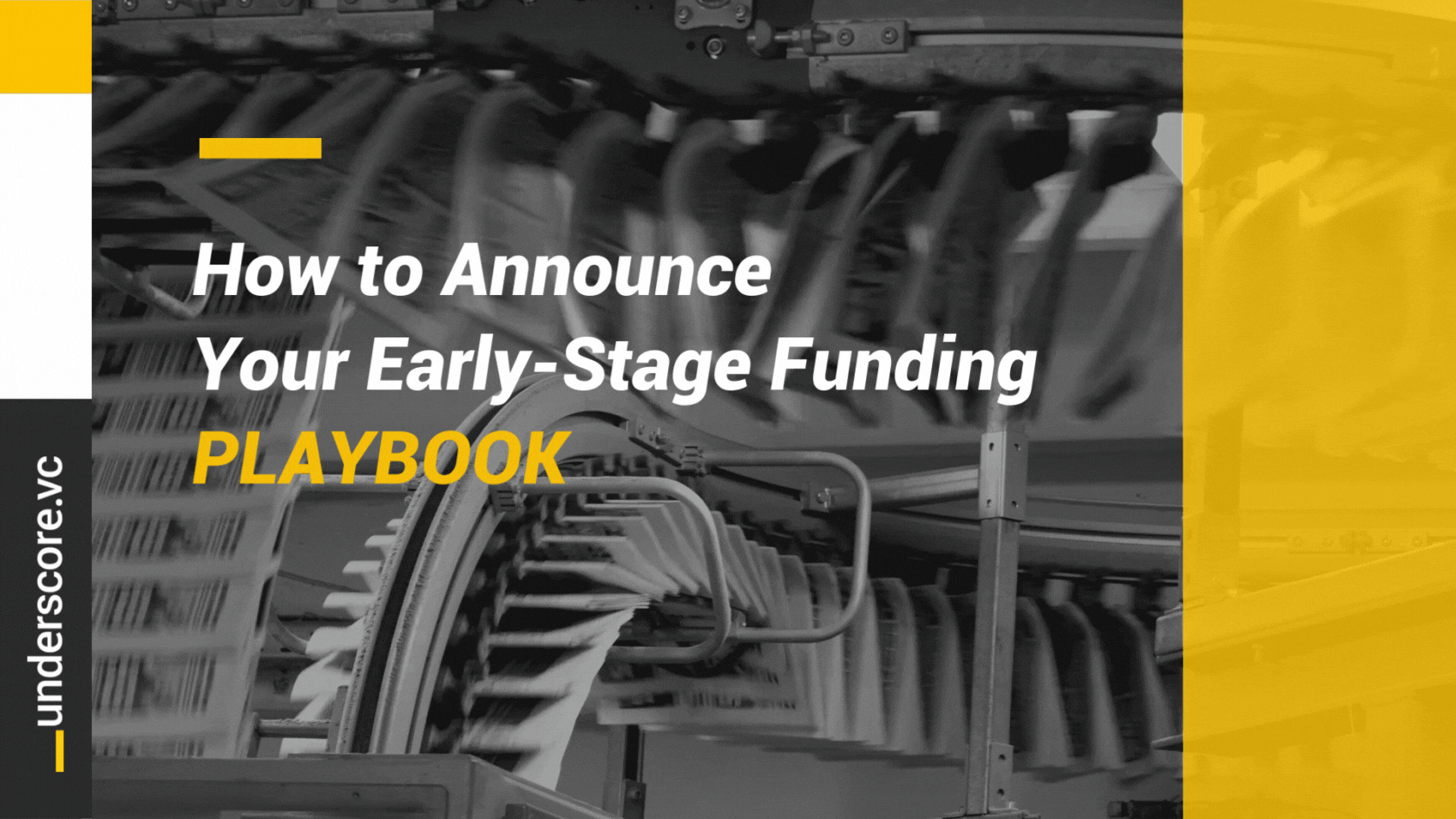We’ve talked about Seed funding milestones and shared toolkits for raising a Seed round, so now it’s time to discuss announcing your successful Seed funding raise!
Some founders can hardly wait to announce their startup’s funding. Others place public relations on the bottom of their priority list, never to be returned to again. The best founders fall somewhere in the middle, wielding the power of PR with intentionality, viewing it as a means to achieve their business objectives.
This comprehensive guide will help you evaluate if, when, and how to share your startup’s Seed round funding news.
KEY TAKEAWAYS
- Your Seed round funding announcement is an incredible opportunity for high-priority audiences—investors, customers, talent, and advisors—to see your company validated.
- Before you capture the opportunity, consider if your startup is ready for press via our pre-press checklist that includes: Nurturing press relationships before you announce, updating your careers page, establishing lead nurturing tactics, nailing your value proposition, and more.
- Determine if a PR agency, freelancer, or in-house job makes the most sense to manage the process of acquiring press coverage, scheduling interviews, and tracking progress.
- While AI tools can’t do all of this work for you, they can surely help streamline your process. This AI-powered Coda Doc is a companion tool to this guide – It will save you considerable time.
In this video, Underscore VC’s Marketing Director Devin Nash gives a crash course on how to announce your Seed funding.
Why Your Startup’s Seed Stage Funding Announcement Matters
For startups, PR can be a cost-effective and influential tool for attracting customers, talent, partners, advisors, and investors. Each of these audiences will inspect your online presence as they evaluate their interest in associating with your startup.
Devin puts it simply: “At the earliest stages of a startup your highest priority audiences will inspect your digital fingerprint, wanting to see that respected, influential people, or outlets, have validated the quality of your business.”
When done right early, PR can have compounding effects. “Think of it like a flywheel. Once you start getting attention, the more attention accrues to you. There is a name for this phenomenon: preferential attachment,” says Jenna Birch, VP of Narrative & Communications at NFX.
In the life of an early stage startup there are a limited number of newsworthy events, but getting VC funding is a validating milestone that you can leverage to stir up early attention, even if that attention doesn’t result in a formal press piece.
As a startup scales beyond Series Seed, and newsworthy events increase, it’s wise to separate funding news from product news. This gives your product a chance to stand on its own, and reduces the likelihood that your product’s perceived value will be tied to the size of your funding round.
Why You Might Not Want to Announce Your Early-Stage Funding
Usually, announcing your funding is a worthwhile effort. However, there are exceptions.
Former TechCrunch Journalist and SignalFire Venture Partner Josh Constine has previously pointed out that “not all press is good press. So consider your announcement and its timing carefully.” He has cautioned founders to “consider that your press could distract from building, expose trade secrets, or get you positive exposure too early before you’re ready to scale up or triage inbound customers.”
Like most things in life, timing is everything. “Some founders make the mistake of not being prepared for the inbound opportunities their announcement could generate,” says Devin Nash. “Stirring up attention is only meaningful if you’re able to harness the energy of it to drive business outcomes.”
Is Your Startup Ready For Press? 7 Considerations to Keep in Mind Before Announcing Your Seed Round
It is the founder’s decision if and when to announce the funding. Avoid creating an arbitrary deadline by evaluating whether your startup is ready for press; here are 7 considerations to keep in mind:
1. Have you nurtured relationships with the press?
When you’re raising venture capital, warm introductions, and pre-established relationships are critical. The same is true of attracting press coverage. Alex Wilhelm, Editor in Chief at TechCrunch, has an inbox that is “chock-full of notes from interesting founders and investors sharing upcoming early-stage rounds.” And the TechCrunch team will only get to write about a few each week.
Given the volume of inbound communications reporters receive, being a recognizable name in their inbox increases the likelihood your email is opened, and read.
To make your name recognizable, you must build rapport with those you’ll someday seek coverage from. Build a list of reporters in your company’s space, read their work, come to understand their writing beat, meaningfully engage with them on social media, and find opportunities to meet them face-to-face over coffee or at an industry event.
“Relationship building is an artful dance, and selflessness is the greatest form of selfishness – providing real tangible selfless-value to a reporter in the form of connections, tips, industry expertise, and opportunities can build your relationship for when the time is right for you to one day make an ask: cover your companies news,” says Devin Nash. She adds, “be thoughtful, nobody likes a stage-five clinger.”
2. Is your startup ready to accept and nurture customer leads?
Regardless of whether a communication is directed at prospective customers, assume they’ll read it, and carefully evaluate how it might land with that audience. You’ll benefit from evaluating your lead capture and lead nurturing tactics in advance of publishing. Here are five questions to consider:
- Do your materials clearly articulate if/when your product or beta will be available?
- Is it evident how prospective partners or customers can get in touch?
- Have you secured your social handles and polished up your social presence?
- Are mechanisms in place to capture leads, for example, on your company’s website?
- Have lead nurturing tactics been established and assigned to the team?
3. Are open roles posted to your careers page?
Funding announcements present a unique opportunity to attract talent to open roles. If you’re planning on hiring, make that clear. Call out the areas of the business you’ll be hiring for and link to your company’s fleshed-out careers page.
Startup Secret: Carefully consider your job descriptions, hiring principles, and candidate interview process. Learn more about how to hire A+ talent for your startup here.
4. Is a plan in place to nurture prospective investors?
Prospective investors will read your funding announcement. So, while it’s important to be thoughtful about what they’ll take away from your coverage, it’s equally important to have a plan in place to nurture investors that might then reach out to you.
Learn more about how to effectively manage inbound interest here.
Startup Secret: Before you begin authoring a release, it can be helpful to speak to your existing investors about what messaging points you need to nail to attract follow-on investors.
5. Do you know your startup’s value proposition backward and forwards?
If your startup is at the Seed stage, it’s possible that you’re still finding product-market fit. That said, before seeking press, get clear on your positioning statement. Here is a simple framework from the First Round Review:
For (target customer) who (statement of need or opportunity), (Product name) is a (product category) that (statement of key benefit). Unlike (competing alternative) (Product name)(statement of primary differentiation).
“Don’t make reporters – or anyone – work to understand your business,” says Kerry Bennett, Marketing Partner at Upfront. “Perfect your ‘TikTok pitch,’” meaning “it’s not just an elevator pitch; It’s also compelling, and interests people in what you’re building.” Kerry shares more here.
6. Have you thought about your Form D filing?
In compliance with SEC regulations, most US-based startups are required to file a Form D within 15 days of closing a financing round. This filing will put your funding information in the public domain and journalists are known to scan for Form D filings here, meaning your news could get picked up before you’re ready.
“A well-known later-stage company is more likely to get lifted from the Form D,” says Jenna. For this reason, those raising a Series B+ typically work to announce their funding at the same time as filing. “Earlier stage companies usually have more flexibility.”
Discussing your startup’s Form D filing with your legal counsel in advance of your round closing is advised. In some instances, your legal counsel can work with you to time the filing out in a way that’s more favorable to your communications timeline.
7. Are you prepared to put in the effort?
As the length of this guide might suggest, a lot goes into public relations. Preparing for attention, securing attention, amplifying attention, and capitalizing on attention are each a high-effort process. Allocate time and resources accordingly. A well-done funding announcement typically takes three months of preparation.
→ Companion Tool Here: Press Ready Check-List
Should You Hire a PR Expert?
“Should I hire a PR agency?” is a common question among early-stage founders. And the answer is, it depends. There are generally three options to consider regarding executing PR:
- Hire a PR agency – 💰💰💰
- Hire a PR freelancer – 💰💰
- Do your PR in-house on your own – 💰
Below is a breakdown of each option. Before you consider any of them, you should ask your investors if they have PR support services for their portfolio companies. If you’ve raised capital from an established venture capital firm, there is a good chance they have a communication professional on staff, or have developed strong relationships with service providers that they might subsidize the cost of.
“If a company only has a funding announcement to put out, and no need for more imminent PR beyond that, then I’d be inclined to advise the founders to heavily lean on their investor’s services,” says Jenna. “As a bonus, they already know your company well and don’t need the ramp-up period a freelancer or agency would need to perform effectively.”
Hiring a PR Agency – 💰💰💰
A good PR agency can cost you somewhere in the range of $10,000-25,000 a month. And, the consensus is, you get what you pay for, so you don’t want to skimp out. Most firms require a minimum retainer, so depending on your operating budget, options may be limited.
If your business is one that relies heavily on consumer attention and trust to drive growth, a PR agency may be the right investment. Additionally, some businesses choose to drown out the competition early with an aggressive PR strategy. The challenge then becomes finding the right one for your company’s unique set of needs. It’s important for your PR partner to have expertise in your industry or market.
If you decide to invest in a PR agency, here are six steps to finding, vetting, and selecting the right PR or marketing agency.
Startup Secret: If you hire a PR agency, you should respectfully ask that they cc you on all press outreach on your behalf, suggesting that the reporter “reach out to you if they have any questions for the company.” It’s a way for you to gather media contacts and build your own relationships with the right outlets. They may not agree to this, but there is no harm in asking.
Hiring a PR Freelancer – 💰💰
A PR freelancer can be a nice “goldilocks” option – it’s not too expensive and it’s not too time intensive for you or your small team. Freelancers will often do one-off projects and can scale up or down to meet your company’s needs with a bit more ease. Additionally, freelancers are often very well-seasoned PR experts; thus their ability to break out on their own. Finding the right freelancer with expertise that aligns with your needs can be challenging, but they’re out there and fellow founders, or your investors, can often make great recommendations.
Do Your PR In-House – 💰
For early-stage enterprise companies, DIY PR is a workable option if you can meaningfully prioritize it and staff it. Here are two questions you’ll want the answer to be “yes” to before you commit to doing it yourself:
- Does a member of your team have a public relations and communications skill set? Or is there a member of your team that is a strong strategic writer?
- Will the person tasked with this work be able to meaningfully allocate time to this ongoing project?
Define The Goals of Your Seed Round Announcement
Regardless of how you plan to resource your funding announcement, you’ll need to define the goals. Only you as a founder can answer how this announcement should advance your larger business objectives.
That said, there are a few common goals to focus on and consider. The goals may differ depending on your company and what you are most focused on, but ultimately you may want to aim to provide coverage for all of these goals:
- Promoting your employer brand for future hiring
- If this is one of your goals, make sure your careers page is ready to go.
- Driving customer awareness and generating leads
- If this is one of your goals, announce when your lead nurturing campaign is ready!
- Creating investor interest for later rounds of funding
- If this is one of your goals, be clear on your funding strategy so you’re prepared for any investor inbound post-announcement.
Ranking your audiences by priority, and then ranking the most important messages for each audience to take away, can help you put a finer point on the goal of your communication and messaging hierarchy. Once you’re crystal clear on the goals of your funding announcement, you should share the goals with all parties involved.
Startup Secret: At the very top of your funding announcement draft, clearly outline the goals of the announcement for easy referencing.
Craft Your Story & Your Creative Assets
If you’ve decided to do your PR in-house, what follows is an outline of how to go about it. If you’ve hired a PR agency or freelancer, they’ll support the execution of what follows next in this guide. In turn, consider this read a primer that will prepare your mind and allow you to more meaningfully collaborate with, and evaluate, your PR partner.
Nail your narrative
Opinions vary on whether to author a press release, founder blog post, or create some other artifact. But it is universally accepted that, regardless of what you create to distribute, you need to nail your narrative. Funding alone is not newsworthy (unless you’ve raised an astronomical amount), so you have to be a compelling storyteller.
Former journalist and current Director of Brand & Marketing at Primary, Katheryn Thayer, says “the formula for a good story is: relevant + recognizable + unexpected + enticing. You want to align with wider trends, name-drop any name-brand associations, share an insight you have proprietary access to, and, most elusively, frame it in a way people will want to hear about and connect with.”
“Be as honest with yourself as you can be,” says Katheryn. After all, as a founder that’s dedicated your life to building this company, you inherently find the work you’re doing to be interesting. For that reason, it can be helpful to workshop your narrative, and key messages, with colleagues and friends who can be objective about the level of interest in each narrative idea. After all, you don’t want to burn your social capital by pitching something that isn’t newsworthy to a reporter.
Whether you decide to write a blog post or create a press release, just be sure that you view your process as a tool to craft your narrative and get team members and investors on the same page. The final output should be a strong foundation that enables you to deliver an excellent funding announcement.
Funding Announcement Ingredients:
- What are you announcing?
- Why is it important for existing or new audiences and the industry?
- Top 1-3 messages you want to convey
- What pain are you helping to solve and how?
- What are the benefits to your audience? Why should they care?
- Why is this news unique or unexpected?
- Evidence: Research, metrics, or proof points that support your claims
- Market trend context – Is your news relevant to a larger trend?
- Why are you and your Co-founder uniquely qualified to solve this problem?
- What notable people or companies are involved?
- Founder or Executive quote
- Lead investors quote
- Customer quote
- Zero buzzwords or industry jargon
→ Companion Tool Here: Funding Announcement Ingredients & Press Release Draft Generator
Develop creative assets that set your story apart
Visuals are increasingly playing a role in driving clicks and engagement. Invest in creating great visuals that grab a reader’s attention and bring to life your value proposition. If you’re including a founding team photo, it’s worth hiring a photographer to take well-lit, high-resolution, landscape (not portrait) headshots, and group shot images. Some members of the press are also excited to receive professional illustrations or a polished animated GIF showing your product. Skip the product screen grabs.
Rich, colorful media is important. Remember, the goal is for your piece to stand out from the hundreds of others published that day.
Determine Who To Pitch & Your Good, Better, Best Outcomes
A growing number of founders are pursuing an ever-smaller pool of journalists in hopes of earning coverage for their startups. Odds are not in your favor. That’s why it’s essential to nail your narrative and be thoughtful about your press outreach strategy. “Think through your good, better, best outcomes,” says Devin. “With those outcomes in mind, you can create a tiered action plan for outreach.” For example:
Best: A full write-up in a top tier publication, mentions in prominent newsletters, and coverage in the main industry-specific publication.
Better: A full write-up in a tier two publication, mentions in prominent newsletters, and coverage in the main industry-specific publication.
Good: Mentions in prominent newsletters, and coverage in the main industry-specific publications.
Only you can define what your “best” outcome looks like, based on the newsworthiness of your narrative, but once “best” is defined you can plot your strategy for trying to achieve it. Word of advice: the best reach goals are achievable. In turn, it’s usually wise not to pitch the Wall Street Journal until your Series C or D round. Publications that cover early stage startup rounds include TechCrunch, Crunchbase News, and VentureBeat. Forbes will also publish founder-centric stories about particularly newsworthy early-stage companies.
Bloomberg, The New York Times, and the Wall Street Journal very rarely cover funding less than $100M, and the Financial Times generally isn’t getting out of bed for anything less than $200M.
Journalist-Story-Fit
As a founder, you know all about product-market-fit, so you likely understand the sentiment behind “journalist-story-fit.” Reporters cover specific topics and industries, and you want to pitch by expertise. Don’t waste your time pitching journalists who are unlikely to bite because their “beat” doesn’t align with your news.
Startup Secret: When targeting a reporter, consider if they might give you additional reach through their own channels. Some reporters tweet and promote all of their articles, while others do not. Ideally, you want someone who will amplify the article alongside you.
→ Companion Tool Here: AI-Powered Journalist Research
A Brief Note on Paywalls
Most outlets have at least some content behind a paywall. Outlets like Forbes are almost entirely behind a paywall, whereas TechCrunch is still mostly free, with select articles behind the TechCrunch+ paywall. It’s worth seeking non-paywalled press, but it’s also more competitive to secure.
When & How to Pitch Reporters
Most reporters prefer to be pitched via email. If you’re doing this right, you’ve thoughtfully researched who you’re pitching and uncovered their preferences. Many members of the press are upfront about their preferences, sharing them in their Twitter bio, personal blog, or via interviews they’ve been a part of. Do your homework.
Then, “starting at the top of your reporter wishlist, send a note roughly every other day, ensuring you don’t double dip at any one publication and being sure to honor commitments you make to the reporter,” says Katheryn.
The Art of The Email – Press Outreach Email Template
Start with your subject line. “The best subject lines make your news and your timeline clear, if you have a hard deadline,” says Devin. “The very best subject lines are strong enough to serve as the headline for the article itself. But don’t get too cute or clever with it.” Your goal is to capture attention and create understanding.
“Always reverse engineer the headlines and ledes of your favorite writers,” says TechCrunch Senior Reporter, Natasha Mascarenhas. A lede is the first sentence or opening paragraph of a news story that immediately grabs the reader’s attention.
For the body of your email, impactful brevity is the name of the game. “Think about this like a sales email drip: Shorter is better; your goal is really just to get on a call,” says Katheryn. In a 2020 survey of journalists, 92% of journalists said the ideal pitch length was capped at 2-3 paragraphs.
Paragraph One: Sentence one is an opportunity to introduce yourself and your company. And sentence two is where you share your news and your timeline.
Paragraph Two: This is the meat and potatoes. Some write this as bullet points, while others write it as a strong short paragraph. Regardless of which you choose, this section should pack a punch, sharing why the work you’re doing matters and is connected to a larger trend (your narrative) and proof points such as partners, investors, prominent advisors, awards, or customers you’ve secured. You’re answering the question: Why should this matter to this publication’s readers?
Closing sentence: Close with a question, “would you like to jump on a call?” For Jenna at NFX this is a non-negotiable. “I cannot stress this enough. You should always ask for an action item as you close out an email – usually a phone call or zoom. It needs to be the very last sentence.”
Who should send the email? Reporters love to hear from the founder, or one of the co-founders, themselves. If you know of someone with a truly strong connection to your target reporter, in that case it may make more sense to have them reach out on your behalf with you copied.
It’s important to note that every email you send should be customized to the reporter you’re reaching out to. It should be clear that you’ve read their stories, understand their beat, and think this story is a fit for them specifically.
Example Pitch Email:
Hi Sarah,
[Personal connection or introduction: It was awesome chatting with you last month at X event.] As a refresher, I’m Noelle the founder of [awesome company], [short form positioning statement: the borderless super wallet helping people in emerging markets fight the inflation rates that are eroding their savings]. Having just [ actions: rapidly raised an oversubscribed $11M Seed round co-led by Tiger Global and Underscore VC], we’re gearing up to announce our funding and [news sweetener: new name brand partners] early next month.
I’ve been reading your great coverage of the rise of inflation, and believe your readers would be interested to learn that [awesome company] is developing products to help people in emerging markets sidestep inflation. Through the use of [impressive technology], [awesome company] helps customers from anywhere in the world access dollars without any fees and earn an 8% yield. Hailing from [country] – which recently had to hike its minimum wage by a whopping 100% to ease the impact of its ongoing inflation crises – my co-founders and I have lived through the frustration of sky high inflation and have global experience building software products for hundreds of millions of users at [impressive roster of companies]. Our beta has organically attracted 20,000 users, and our early traction has earned us [award] and an angle investment from [well-known person].
I believe [publication] readers will be interested in learning more, and I’m happy to share a press release with you – would you like to jump on a call?
Timing Your Communications
Like so many things in life, timing is everything. In a 2020 survey for journalists, 20% indicated that they prefer pitches to come in on Monday, and 64% said they preferred morning pitches. These are stats to help guide your outreach strategy, but every reporter has different preferences.
One general rule of thumb is to provide ample lead time and, when possible, be flexible. “Your chances of coverage in your highest priority outlet improve when you can work on the reporter’s timeline. It may be the case that they genuinely want to cover your story but won’t be able to get to it for several weeks,” says Devin.
What if the reporter doesn’t respond?
Follow up and don’t take it personally. Members of the press have unreasonably full inboxes, and it would be impossible for them to respond to every email. 51% of journalists surveyed thought that 3-7 days was the sweet spot to wait on following up with an email. It’s OK to follow up with a nudge 2 days later, and a 3rd and final nudge 2 days following that. If you don’t hear back, it’s likely time to move on to your next best target.
“If you’re pitching and pitching without any traction, consider moving back your launch date a couple weeks,” says Katheryn. “If that backup date still doesn’t get any bites, I’d recommend publishing your own story on your company blog, making a LinkedIn article, or seeing if an investor would write a post about you. Even if you do get a press placement, these are great things to have ready to go and post shortly after the article goes live.”
Embargos & Exclusives: Tools in Your Toolbox
Think about using embargos and exclusives as tools. But first, what the heck is an embargo or an exclusive?
What is an Embargo? And should you have one?
An embargo is a date and time restriction on the release of information to the public. Embargoes are used to give reporters advance notice, allowing them time to prepare their coverage so it can go live the moment the announcement is made. This can ensure accuracy of information, and give companies time to prepare for publicity.
If you’re circulating a press release to select reporters seeking coverage on a specific timeline, you can place an embargo date and time at the top of your release. When a reporter agrees to your embargo, they’re committing to not publishing your news until after the embargo has been lifted; in other words, it’s past the date and time agreed to.
Note the use of the word “agree” here. A reporter needs to agree to your embargo. You can’t simply assert that something you’ve shared is under embargo. “This bit is super important and often overlooked in the order of operations,” says Lindsay McCallum, Director of Marketing & Communications at Headline. “If you’re pitching your announcement and want to make sure the news breaks on a specific date, ask the reporter if they agree to the embargo before giving them all the details or sitting for an interview.”
Startup Secret: Most embargos end on Tuesday morning. So unless your announcement is going to be the big news of the day, you’re going to get crushed on Tuesday. In turn, you may be better suited to pick Monday, Wednesday, or even Thursday. Regarding the time on the embargo, most put 8:00am ET, so choosing 8:15 or 8:45 might help your article sit closer to the top of a website’s article list for longer.
For an early-stage funding announcement, an embargo may not be necessary and could complicate your outreach. “Don’t be overly precious about withholding information until a reporter agrees to an embargo,” says Katheryn. “That’s my personal pet peeve. I see PR professionals do this a lot and don’t think it matters. It just makes you harder to correspond with.”
What is an Exclusive? And should you arrange an exclusive?
When you offer a media outlet an “exclusive” you’re offering them exclusive rights to your news so they can break it first to their audience. Reporters increasingly care deeply about exclusives.
“More frequently reporters are telling me that their publication is prioritizing exclusives and scoops. In a crowded media landscape, they want to be breaking news first and generating the clicks that come along with that,” says Devin. “If 5 outlets are publishing the same news, they’re getting split attention – split clicks.” For this reason, offering an exclusive is a common strategy for securing coverage of a Seed stage announcement.
Consider offering an exclusive when:
- You believe it will increase your chances of securing coverage in your most sought-after publication.
- You have a complicated, or sensitive, story to share, and the ultimate press piece would benefit from the greater lead time and deeper reporting.
“Even if you have an exclusive, you can still pitch the news out to others once the exclusive story is live,” says Lindsay.
Should You Put Your News Across “The Wire”
The short answer is: No. At the early-stage, it’s an unnecessary cost that will yield very little ROI. If you are going to post to PR newswire or a similar platform, make it the very last thing you do. “When you put your news on the wire, you’re signaling to journalists that your announcement is old news,” says Devin. “Every human on the planet has access to that information now, so a reporter is no longer incentivized to cover it.”
“Unless the company has a global userbase or global ambitions, i dont think a wire really makes sense as long as they have a strategy in place to pitch the funding news out broadly on announcement day. Wires can be helpful for reaching corner of the world you might not otherwise reach, but are so costly it rarely leads to good ROI,” says Lindsay.
Nailing Your Press Interview
It’s an exciting moment when your press outreach results in an interview. However, be aware that your interview does not guarantee a story. You’ve still got to earn interest in your one-on-one interview with the reporter. Note that one-on-one is the preference of most, it not all, reporters.
With your interview scheduled, it’s time to focus your energy on interview preparations. Taking a formal media training class is highly encouraged, but here are the cliff notes:
Write The Billboard
A media interview is an opportunity for you to author a billboard for your company – what do you want it to say? While an interview is a two-way exchange, you need to be crystal clear on your desired output. Work to satisfy the journalistic needs of the person interviewing you, but never lose sight of the billboard message. Let it ground you.
Supporting Messages
You’ve written the headline with the billboard exercise, and now it’s time to nail down the three critical supporting points. What are the three things you want the eventual reader/watcher to take away? List them. Edit them to sound punchy. Order them. Double-check them. Keep them with you.
Crash Course: Media Training
There are some journalistic terms that it’s important to understand before you speak with the press. Below are some phrases that determine the guardrails of your conversations and what from your conversations can and cannot be made public.
The differences between speaking off the record, on background, or not for attribution are what you and the reporter to whom you’re speaking collectively agree they are. Agreement is required. However, there is no official journalistic body that enforces this code of honor. In turn, assume that your words will be printed and attributed to you.
“On The Record”
When speaking “on the record,” everything you say can be reported and attributed to you. It’s a best practice to assume everything you say is on the record.
“Off The Record”
When speaking “off the record,” the information provided, in theory, is not for publication and is not even to be recorded.
“Not For Attribution”
When speaking “not for attribution,” your words can be quoted, but not attributed to you. For example: “a source close to the matter said ‘the company was underwater financially.’”
“On Background”
Definitions of “on background” vary. Some journalists believe it to be the same as “not for attribution,” while others believe that information given “on background” can only be paraphrased, but the source cannot be named or quoted directly.
If you find yourself in a situation where you don’t recall the meaning of these terms, don’t sweat it. Jenna at NFX reminds us that “it is always acceptable to explain – in plain language – the terms of the interview that you’d like to abide by.
Be Prepared to Answer These Questions
To increase the effectiveness of your preparations, do several mock interviews with a colleague or friend. Encourage them to help you weed out buzzwords from your responses, and flag when you’re response to a question, isn’t punchy or is too long-winded. No matter how seasoned you are, or how much you know your industry/product/company, it’s essential to practice. At the very least, you’ll come off more polished.
Here are some questions to be ready to answer. (P.S. There are many of the same questions a prospective investor will ask you):
-
- Why is this the problem you’re dedicating your life to solving?
-
- Why are you and your team uniquely qualified to solve it?
-
- How did you come up with your solution? Where did you take inspiration from?
-
- How does your solving this problem make the world better?
-
- How does your company make money now and how will it do so in the future?
-
- Who are your investors and how will their experience help you?
-
- How do you grow sustainably?
-
- Why do people stop using your product? What are your retention and churn?
-
- Who are your competitors? (Don’t try to dodge this one. Everyone has competitors.)
-
- Why will your company win out over your competitors?
-
- Why couldn’t a big player just shift into this space?
-
- What keeps you up at night? What are your plans to alleviate those concerns? (Tell them something specific to your business and how you plan to solve it. Hiring and raising money are cop-out answers.)
-
- What are the adjacent markets?
-
- What are your next steps? You just raised some money, how are you going to spend it?
“Whatever happens, don’t say this”
Just as important as identifying what you do want to say is identifying what you don’t want to say. Identify where your guardrails are and what you’ll have to steer clear of. This way you can go into an interaction with a strong mental framework around what you do and do not want to talk about and won’t have any regrets about sharing something you wish you hadn’t.
Know Your Bridging Phrases
Sometimes an interviewer might throw a curve ball at you, but don’t worry, you’re prepared, because you’re about to read several helpful bridging phrases. A bridging phrase helps you get back to the talking points you care about. Examples include: “That’s an interesting observation, but more importantly…” or “I would not say that, but what I would say is…” Here are some other examples:
- Keep in mind that…
- Let me tell you what we’ve been seeing…
- I’m not sure that’s the case…
- The thing we’re focusing on most is…
- Great question, but what is important to understand is…
- I’m not an X expert, but what I do know is…
Follow Up
Yes, say “thank you.” But also follow up with anything you owe the reporter: stats, images, clarifications. Anything you didn’t immediately know the answer to should receive an “I’ll confirm and follow up” – never guess. And don’t forget to take note of those items! “It seems obvious,” says Lindsay, “but many forget in the heat of the moment to take notes as a reminder for anything you promised to follow up on!” Your follow-up is also a great time to confirm when the piece will run.
Amplify Your Press
So you’ve written your press release, pitched to reporters, scored an interview, and it’s about to be the big day! Your news is about it hit the public, but you are not done. In fact, this is when it’s critical to double down on your planning efforts and create rolling thunder by leveraging the reach of your broader network. Here are some things to consider:
Low-Hanging Fruit Publications
Do you have a list of medium and lower-priority reporters you should share your news with right after it hits? This could create some additional smaller stories and buzz. Don’t discount industry trade publications; Despite not having national reach, they usually reach the right audience.
Do you have a list of newsletters you should be reaching out to with the link to your news once it is live? This is a great way to get in the inboxes of your local ecosystem.
Tap Into The Reach of Your Team, Advisors, VCs, Angel Investors, Family, and Friends
Despite being an early stage startup, you’ve likely developed a strong network of supporters and stakeholders that helped you successfully raise a Seed round, and it’s time to ask them for a favor: Share your news!
“Note investors who’ve backed you or communities you’re a part of: They’re likely to be excited about amplifying your story. These types of cheerleaders are so, so important to your overall distribution plans, whether you get the story placed or end up writing it yourself,” says Katheryn.
Align with your existing and new investors 3 weeks out. Setting up a coordinated game plan with your investors is critical for your funding announcement to go smoothly. Remember, your investors likely have social media reach, a widely distributed newsletter, and a rolodex of media connections to tap into.
Startup Secret: Develop a one-page “media kit” outlining when and how you would like your extended network to share your news. The more specific you can be, the better. Include the link you want social media posts to direct to and provide some sample language and hashtags for those promoting your news to build off.
Don’t overlook your own social media. Perhaps you haven’t built up a strong following yet on social media, but that’s OK – this is an opportunity. Be sure to be posting things that your employees and investors would get excited to re-post – this can grow your following.
Speaking of your employees, your team is your secret weapon. Use employee engagement to create a personal touch to promotion and create a “surround sound effect” on social feeds. Individual social accounts perform better than branded social, especially on LinkedIn. Send an email blast to your team as soon as the news hits and ask that they post to their networks. The more specific you can be around what you would like them to say the better – don’t assume it’s obvious.
→ Companion Tool Here: AI-Powered Amplification Email Generator
Follow-Up To Create a 2nd Wave
As the day and the week progresses, you can collect press and influencer mentions into a shared report. Send an update to your team, advisors, and investors towards the end of the day on day one, or on day two. Often, doing this creates a 2nd wave of posts and engagement because your report gives them more social media ammunition.
Remember: This is Hard Work. Don’t Get Discouraged.
There is a reason PR agencies charge an arm and a leg; it’s hard work. Securing coverage can often feel like an uphill battle. But you’re a founder, so you already know you can do hard things!
In turn, don’t get discouraged. And try to remember that your worst-case scenario isn’t a bad one: You put out a blog post and leverage your network to amplify your news.
Along the way, you’ll no doubt fine-tune your communication skills and create meaningful connections with reporters, and that’s hard work that’s worth celebrating and will also set you up for success on your Series A funding announcement.














